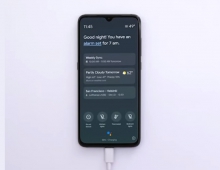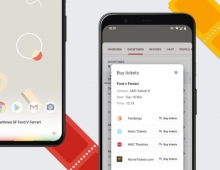
Google Assistant Gets Smarter and More Natural
Today at I/O, Google shared its vision for the next phase of the Google Assistant, as Google is making it more naturally conversational, visually assistive, and helpful in getting things done.
Google announced our vision for the Google Assistant just two years ago at I/O, and as of today, the Google Assistant is available on more than 500 million devices, it works with over 5,000 connected home devices, it's available in cars from more than 40 brands, and it's built right into the latest devices, from the Active Edge in the Pixel 2 to a dedicated Assistant key in the LG G7 ThinQ. Plus, it'll be available in more than 30 languages and 80 countries by the end of the year.
Google says it has dramatically improved the language understanding so you can speak naturally to your Google Assistant and it will know what you mean.
One of the most important parts of the Assistant is its voice - it needs to feel both personal and natural. Up until now, creating a new voice took hundreds of hours in a recording studio. But with advancements in AI and WaveNet technology from DeepMind, Google can now create new voices in just a few weeks and are able to capture subtleties like pitch, pace, and all the pauses that convey meaning, so that voices are natural-sounding and unique. Starting today, you can choose from six new voices for your Google Assistant. And John Legend will lend his melodic tones to the Assistant later this year.
Gogole promised that soon you'll be able to have a natural back-and-forth conversation without repeating "Hey Google" for each follow-up request. The Assistant will be able to understand when you're talking to it versus someone else, and will respond accordingly. This feature is coming in the coming weeks.
A key part of having a natural conversation is being able to ask about many things at once. With Multiple Actions, which is already starting to roll out, the Google Assistant will be able to understand more complex queries like "What's the weather like in New York and in Austin"
Assistant features for families - powered by Family Link - provides free family-friendly games, activities, and stories. To help you give your little ones some positive reinforcement when they ask nicely, later this year Google will introduce Pretty Please, so that the Assistant can understand and encourage polite conversation.
Earlier this year Google launched six ready-made Routines to help you get multiple things done with a single command. Starting today, Gogole is rolling out Custom Routines, which allow you to create your own Routine with any of the Google Assistant's one million Actions, and start your routine with a phrase that feels best for you. For example, you can create a Custom Routine for family dinner, and kick it off by saying "Hey Google, dinner's ready" and the Assistant can turn on your favorite music, turn off the TV, and broadcast "dinner time!" to everyone in the house. Later this summer, you'll be able to schedule Routines for a specific day or time either using the Assistant app or through the Google Clock app for Android.
So far the Assistant has been centered on the verbal conversation you can have with Google, but now Google is bringing the simplicity of voice together with a rich visual experience.
Smart Displays are a new category of devices built for the home that let you glance at responses provided by the Google Assistant. You can access the Assistant hands-free by voice, but you can also tap and swipe the screen when that's easier. You can follow along with a recipe, control your smart home, watch live TV on YouTube TV, and make video calls with Google Duo. Smart Displays come integrated with Google services like Calendar, Maps, and YouTube. The first Smart Displays will be available for purchase starting in July.
Google is also redesigning the Assistant experience on the screen that's with us all the time - our phones. The Assistant will give you a quick snapshot of your day, with suggestions based on the time of day, location and recent interactions with the Assistant. To provide a summary of tasks and list items, Gogole is integrating popular notes and lists services from Google Keep, Any.do, Todoist and many more. Google is also bringing a new food pick-up and delivery experience to the Assistant that isn't constrained by a chat-style interface, so you can order from Starbucks, Doordash and Applebee's, in addition to Dunkin Donuts and Domino's. The new visual design will be available in the Google Assistant app later this year.
The Assistant is coming to navigation in Google Maps later this summer, with a low visual profile so you can keep your hands on the wheel and your eyes on the road. You'll be able to send text messages, play music and podcasts, and get information without leaving the navigation screen.
This summer, Google will also start testing a new capability within the Google Assistant to help you make restaurant reservations, schedule hair salon appointments, and get holiday hours. Just provide the date and time, and your Assistant will call the business to coordinate for you. If a business uses an online booking service, the Assistant will book through that. And if not, the Assistant will call the business on your behalf.
Powered by a new technology we call Google Duplex, the Assistant can understand complex sentences, fast speech, and long remarks, so it can respond naturally in a phone conversation. Even though the calls will sound very natural, the Assistant will be clear about the intent of the call so businesses understand the context. Once your reservation or appointment is booked, the Assistant will add a calendar reminder for your appointment and allow you to cancel if needed.
Gogole is also bringing Google Home and Google Home Mini to seven new countries later this year: Denmark, Korea, Mexico, the Netherlands, Norway, Spain and Sweden. The company is also launching the Google Assistant in Spanish for Android Oreo (Go edition) phones soon.
You can start trying some of these today in the Google Assistant app for Android and iOS. And your smart speaker devices like the Google Home will be automatically updated with the latest features once they're available.





















